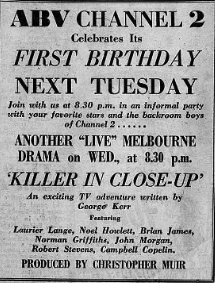Related Research Articles
Autumn Affair is an Australian television soap opera made by and aired by Network Seven station ATN-7, and also shown in Melbourne on Nine Network station GTV-9. Television in Australia had only been broadcasting since 1956 and Seven Network was the first commercial station to make drama a priority.
The Story of Peter Grey was an Australian television daytime soap opera produced by the Seven Network and first broadcast in July 1962. James Condon starred in the title role as a church minister.
Sumner Locke Elliott was an Australian novelist and playwright.
Peter Cotes was an English director, producer, actor, writer and production manager.
The One Day of the Year is a 1958 Australian play by Alan Seymour about contested attitudes to Anzac Day.
Serpent in the Rainbow is an Australian mini series which first screened on the ABC in 1973. It was set in the late 19th century.
Roundabout is a television movie, or rather a live television play, which aired on Australian television in 1957. Broadcast 4 January 1957 on ABC station ABV-2, it is notable as the first example of television drama produced in Melbourne.

Killer in Close-Up was a blanket title covering four live television drama plays produced by the Australian Broadcasting Commission in 1957 and 1958. It could be seen as the first anthology series produced for Australian television.
The General Motors Hour was an Australian radio and television drama series.
Goodbye, Gloria, Hello! is a 1967 TV play broadcast by the Australian Broadcasting Corporation. It ran for a little over an hour and aired on the ABC on 10 April 1967. It was written by Peter Kenna. It was based on a stage play.

Fury in Petticoats is a 1962 television play broadcast by the Australian Broadcasting Corporation. It was directed by Christopher Muir. It was based on a play which had been filmed by British TV the year before.

The House of Mancello is a 1962 Australian TV drama shot in Melbourne about a new Australian family.

Light Me a Lucifer is a 1962 Australian television comedy film which aired on ABC. Written by John O'Grady, it starred Frank Thring as the devil, along with Wyn Roberts, Edward Howell, Joan Harris, Ken Goodlet and Lynne Flanagan. It was produced in Melbourne.
"Suspect" is a 1961 Australian television play. It was originally made for HSV-7 then presented as part of the General Motors Hour It was produced by Peter Cotes, who had made Long Distance. "Suspect" aired on 3 June 1962 in Sydney and Melbourne, and on 7 October 1962 in Brisbane and Adelaide.
"Candida" is a 1962 Australian television play.
"Shadow of the Vine" is a 1962 Australian television play adapted from a 1949 play by Beverley Nichols. It aired on 7 October 1962 in Sydney and Melbourne, and on 3 June 1962 in Brisbane and Adelaide.
"Flight into Danger" is a 1966 Australian TV play. It was based on a 1956 Canadian TV play by Arthur Hailey which had been filmed as the movie Zero Hour!. The episode aired on 14 September 1966 in Melbourne, on 5 October 1966 in Sydney, and on 12 October 1966 in Brisbane.
"Shadow on the Wall" is the 15th television play episode of the second season of the Australian anthology television series Wednesday Theatre. It was recorded in 1967 as part of Australian Playhouse but was not aired until 10 April 1968 in Melbourne and Sydney as part of Wednesday Theatre. It was a rare contemporary Australian TV drama to address the Vietnam War.
"Shadow of a Pale Horse" is a television play that was produced for Australian TV by Sydney station ATN-7, it was also shown in Melbourne on station GTV-9, as this was prior to the creation of the Seven Network and Nine Network. "Shadow of a Pale Horse" aired on 17 September 1960 in Melbourne and Sydney.
The Last of the Ryans is a 1997 Australian biopic TV film about Ronald Ryan.
References
- ↑ "Peter Cotes Drama Out of Storage". The Age. 31 May 1962. p. 8.
- ↑ "Untitled". The Age. 8 June 1961. p. 12.
- 1 2 "Peter Cotes Drama Out of Storage". The Age. 31 May 1962. p. 8.
- ↑ Vagg, Stephen (18 February 2019). "60 Australian TV Plays of the 1950s & '60s". Filmink.
- ↑ "TV Guide". The Age. 1 June 1961. p. 32.
- ↑ "Credit Squeeze Hits Plans for Drama". The Age. 20 July 1961. p. 11.
- 1 2 "First Peter Cotes HSV-7 Production Has a Cast of 15". The Age. 4 May 1961. p. 23.
- ↑ "Teletopics". The Age. 15 June 1961. p. 13.